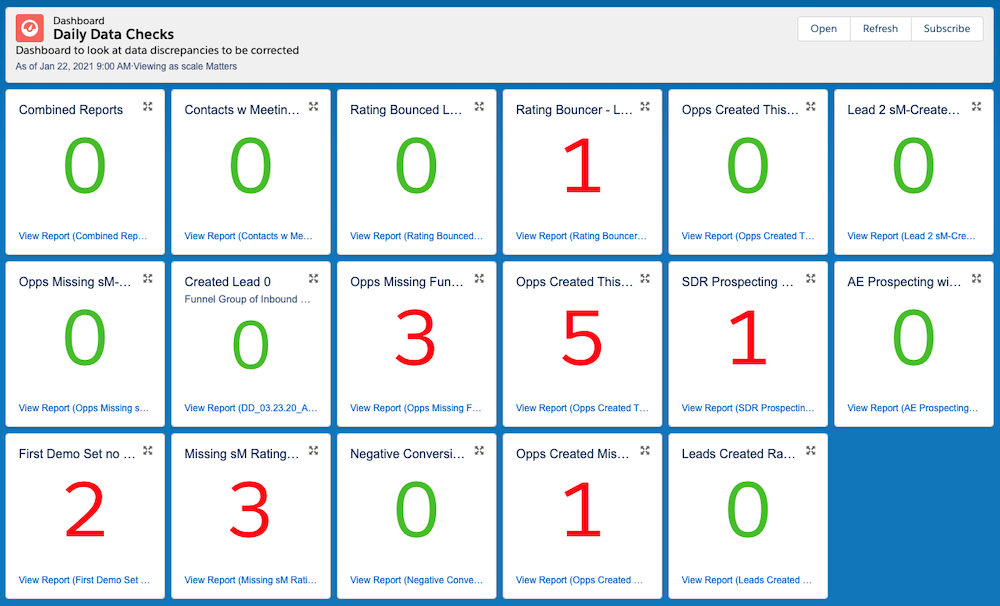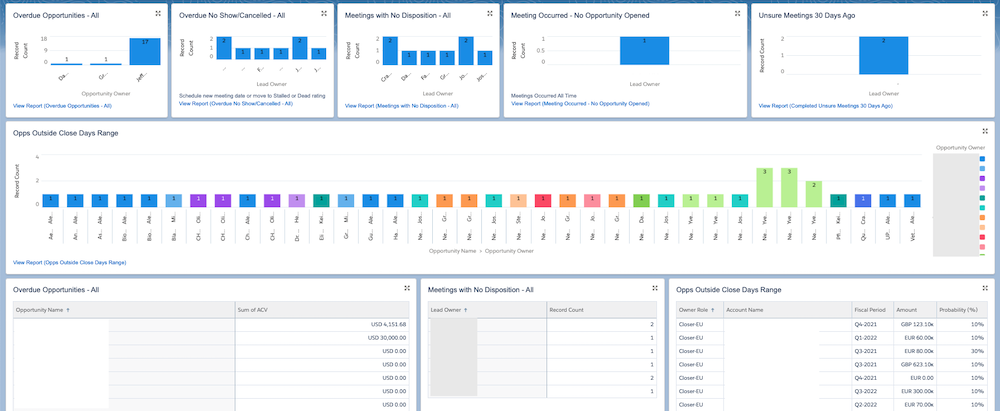Why B2B Revenue Leaders are Falling for the Myth of Being "Data-Driven"
Has there been any phrase more overused in business lexicon over the last two decades than “data-driven”?

This article is for revenue leaders and RevOps people who are frustrated with the inability to get trustworthy data to make smart analytical decisions.
Even if your sales and martech stack is a who’s who of G2 category leaders, your ability to manage can still be handcuffed by data inconsistencies, missing data, duplicate data or conflicting data in sales and marketing.
Unlike highly regulated industries (such as pharma or banking) or business units (such as accounting or finance) where missing or invalid data can result in fines, closure or worse penalties, the sales and marketing function doesn’t face the same level of scrutiny when it comes to data quality.
Worse still, the end users responsible for creating and updating much of the data don’t have a reputation for being obsessed with data integrity. Salespeople have been known at times to resist CRM adoption amidst the pressure to close business and marketing people have been known to skip important steps in the rush to launch campaigns.
This leads to all kinds of data integrity problems that negatively impact revenue.
As we’ve cited before, according to Salesforce and Data.com, the average business loses 30 percent of its annual revenue to poor data quality.
Nearly every growth-stage tech company we encounter complains about the state of their CRM data. Dirty data in sales and marketing systems is a universal frustration. The typical response? A massive, one-time data cleanup initiative.
Companies often invest hundreds of thousands—or even millions—of dollars in these projects, hiring expensive Salesforce consultants or internal teams to tackle the problem. Yet, six months later, the data is back in shambles. Why? Because periodic CRM cleanups don’t solve the underlying issues that caused the data to degrade in the first place.
Here’s why these cleanups fail and what companies can do to maintain CRM data integrity over the long term.
Most cleanup projects focus on scrubbing the data but don’t address why the data became unreliable. For instance:
Without diagnosing and addressing these root causes, the same problems will resurface.
A successful data-driven organization requires cultural buy-in that prioritizes clean, accurate data. Unfortunately, many companies don’t elevate data integrity to a business-critical value. It takes organizational discipline to treat CRM data as a vital asset rather than a secondary concern.
When new VPs of Sales or Marketing join, they often overhaul existing tools and processes. They may switch platforms, change workflows, or redefine how data is captured—without evaluating the impact on historical data.
These changes can undermine past cleanup efforts and create incompatibilities in the data fabric. Protecting the data model and ensuring compatibility with historical data must be a priority.
Periodic cleanups aren’t enough. Instead, companies should implement Data Integrity Protocols—a combination of preventative and corrective mechanisms that ensure data remains clean and usable over time.
Assuming you’ve already completed the process of cleaning up your data and putting in a data model, here are 9 ways to enforce data quality in sales and marketing...
Though AI and automation have taken much of the data entry burden off of human beings, getting quality data in sales and marketing still depends heavily on human accuracy.
Marketers create campaigns to drive demand from a variety of channels, so the ability to precisely track performance depends on how thorough they build their conversion funnels. (Think: UTM tags, forms, form fields, hidden fields, chat bots, automations and workflows, duplicate checks, routing and distribution to sales, etc…)
Salespeople perform a variety of activities in order to convert leads into deals won. They correspond over email/text/chat, make phone calls, communicate on LinkedIn, all while updating product and pricing fields in the CRM, which creates metadata that is essential for analysis.
With so much dependence on humans to produce and maintain an environment of data quality, you as a revenue leader must ensure that their people understand why quality data is important, what decisions are made based off of their data, and why their commitment to data quality is critical to the success of the company as a whole.
Otherwise, the team may mistake your insistence on data integrity for micromanagement and come to work afraid that “Big Brother” is watching their every move.
It’s important to help the team understand that great data helps you identify who needs more coaching and development, plan and deploy marketing dollars efficiently, and operate more intelligently.
Salespeople: When you keep your pipelines and deal projections updated, you are helping our customer success team more accurately capacity plan for the amount of customers they’ll need to onboard after you close them.
If the customer success team doesn’t have enough people to handle onboarding efficiently, customers are more likely to debook or churn (hurting your top line and retention numbers). If customer success hires too many people, then COGS increases and gross margins are depressed.
Either way, data quality impacts the entire company!
After achieving buy-in on the why behind data collection is paramount, you need to take steps to make it easy for the team.
One of the common ways incomplete records creep into your tech stack (if at all) is through offline lead sources and manual data entry into the CRM.
We recommend that separate lead forms are created to handle incoming emails or phone calls from net new leads. Whoever is managing the email inbox or manning the phones can then manually enter that contact information into a lead form, which can properly tag the inquiry source “email” or “phone” and leverage hidden fields to tag important metadata to the record.
After manual entry into the form, this lead will go through the normal automations and routing distribution like any other lead form conversion.
Unfortunately, spreadsheet uploads are still a part of life as a marketer. Events, cold call lists, third party webinars or lists from other databases are common reasons we still depend on Google sheets, CSV, or Excel files.
If you have a revenue operations, marketing ops, or sales ops function, we recommend having them involved in the upload process to ensure that the database file is formatted properly, that the right metadata is created, and that the upload doesn’t produce duplicate records.
Hey, marketers: In the rush to publish and/or promote a new demand generation offer (such as an ebook, webinar, etc.), don’t skip the important details!
Years ago, our marketing team began promoting an existing ebook offer on Facebook Ads through the Facebook Lead Ads & HubSpot integration.
They launched the ad campaign, but failed to update enrollment criteria on the existing automation workflow that was responsible for tagging and distributing the leads. It was enrolling people who downloaded the offer through the website, but not through the Facebook Lead Ads form.
It took almost a week before they realized that the hundreds of new leads from the Facebook Ads campaign hadn’t gone through any automation and therefore hadn’t been distributed to salespeople.
Lesson learned!
Since then, we have used a quality control checklist for new campaigns or programs. It’s roughly 20 steps and looks like this:
⃞ Create offer
⃞ Upload offer into marketing automation platform
⃞ Create campaign in Salesforce
⃞ Create Landing page copy, creative
⃞ Update Page Name, Title, URL, meta description
⃞ Create Form public fields
⃞ Create Form hidden fields
⃞ Thank you/Confirmation Page
⃞ Ensure landing page submission link to correct Thank you page
⃞ Offer download
⃞ Confirmation/Follow up Email
⃞ Create Post-Conversion Automation/Workflow
⃞ Ensure proper enrollment conditions into workflow
⃞ Sync to CRM (if not all-in-on)
⃞ Routing distribution to sales person
⃞ Sync to Salesforce Campaign and set campaign status
⃞ Proper UTM tagging for offer promotion
⃞ Send multiple test leads through
If we really want sales people to focus on setting meetings and closing business, but also expect them to be held accountable for keeping the CRM up to date, it’s on revenue leaders and revenue operations to create an environment for sales people to easily do both.
Too much CRM customization leads to different sales people operating in the system differently. Too many CRM fields exposed to sales people makes it impossible for them to focus on updating the fields that matter. And too many software applications and their barrage of alerts results in schizophrenia. With an overwhelming amount of notifications, salespeople struggle knowing which leads to prioritize.
We recommend the following:
This is especially important if you’re running a high-velocity engine with dozens of new leads coming in per day. Make sure you’re cross-checking your marketing automation, sales enablement, and CRM software on a daily basis to ensure that leads aren’t getting held up by broken workflows, API limitations, weak 3rd party integrations, and improperly tagged records.
Think of this daily activity as a failsafe for both human error and software integration failures.
At scaleMatters, we use a “Daily Data Check” dashboard to flag data anomalies so they can be fixed before spiraling out of control.

Whether it’s sloppiness, lack of focus, or human error, CRM records owned by salespeople often become outdated. If not monitored and fixed, issues like this can balloon out of control, warp reporting and mislead leadership teams.
The “Clean Your Room” dashboard flags outdated records so that they don’t stay perpetually outdated and so salespeople can be alerted and quickly fix:

One way to ensure leads and opportunities stay up to date is to set weekly calendar reminders for salespeople to update records. This requires sales management support and enforcement.
Here’s what we recommend:
Sales managers should tell their teams: “Before you sign off on Friday, end your week by clearing out your “Clean Your Room” dashboard. Anything in your ownership that is flagged on that dashboard must be fixed.”
Add a recurring calendar reminder during an off-hour (such as Friday at 4PM) and invite the whole team. Hey, you can even turn it into a Data Cleanup Happy Hour and make it something the team looks forward to!
If Friday isn’t the right day, this same weekly cleanup activity can be required before the weekly sales team forecast meeting or before a weekly one-on-one meeting with the sales manager.
Applying consequences for poor quality data management or incentives for high quality data is the trickiest part of enforcing data integrity protocols.
What if the sales person with the cleanest, most up to date CRM data is the worst at closing business? Are you going to reward that person?
What if the salesperson who never updates their opportunity close dates is by far closing the most new deals? Are you going to punish that person?
Here are a few tips for navigating this:
You never want to set the precedent in the sales department that data > revenue.
But, the hard truth is that great data integrity does lead to higher revenue growth, it’s just a longer play. Great data integrity accurately informs leadership of what strategies they should invest in more and which strategies should be fixed or abandoned. When you pour more money into sourcing strategies that produce more high quality leads, the sales team has a higher chance of closing more deals!
As important as it is to make sure the team understands the “why” behind data integrity protocols, it’s equally important to include them in the discussion on an ongoing basis.
We suggest consistently asking your sales, sales development and marketing teams to openly share their feedback with RevOps, SalesOps, or Marketing Ops.
Are there fields that are difficult to find? Are there actions that take too long? Are there manual processes that could be automated? Are there too many or too few lead activity notifications?
Getting feedback on questions like that can be useful, but be sure to set the following expectations with the team:
Recently, we onboarded a 50-person global B2B sales team onto the scaleMatters data model and our recommended third party tech stack. Shortly after the global team began receiving lead distribution by region, we got feedback that a large portion of the leads were using personal email addresses (@gmail, @yahoo, etc) and the vast majority of those leads were NOT legitimate buyers.
This was great feedback, but it didn’t apply equally to every region or industry. We couldn’t simply BLOCK free email addresses across the board.
In Africa, the lack of technology infrastructure at certain companies, industries, and governments forces employees to revert back to using personal email accounts for business use. So our customer’s sales people in Africa still wanted to receive leads with free email addresses.
Furthermore, in America, our customer sells to pre-revenue start-ups in certain industries, and large companies in others. Often, pre-revenue start-ups don’t have Google for Business or Microsoft 365 setup, so they are filling out demo request forms with personal email addresses. The sales people for those niche industries still wanted to receive leads with free email addresses.
In response, we built a sophisticated, automated lead routing mechanism that solved all of these concerns. This is an example of sales and ops working in tandem to make closing sales easier!

Has there been any phrase more overused in business lexicon over the last two decades than “data-driven”?

When growth flatlines for investor-backed tech companies, board members start pressing the CEO for answers... “What’s going on?" "Can you get back on...

Spewing, hand-waving and back-pedaling. I can’t even count how many times across so many companies as CEO or Board member that I’ve asked questions...